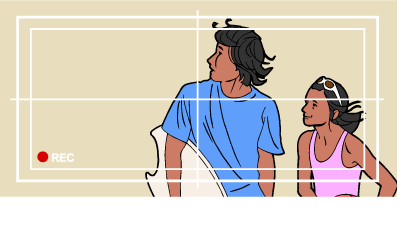Lesson 4.3C: Characters and Point of View
 Have you ever finished reading a story or a novel, put the book down, and felt a sort of sadness that the experience was over? Many readers feel this loss when a story comes to a close because they have felt close to the central character or characters. Finishing the story becomes a bit like losing a friend. Have you ever finished reading a story or a novel, put the book down, and felt a sort of sadness that the experience was over? Many readers feel this loss when a story comes to a close because they have felt close to the central character or characters. Finishing the story becomes a bit like losing a friend.
Characters are like people in real life. We like some of them and can't stand others. Characters can be fully developed and contradictory people who we feel we can relate to. They can also be one-dimensional figures with whom we don't sympathize at all. This is part of the joy of reading stories, to join the social world of other people, and, for just a while, to experience their world.
This lesson will explore the point of view of a story, with particular attention paid to the first-person point of view, in which a character tells the story from his or her perspective. We will look more closely at character, character traits, and how characters make a story meaningful and enjoyable.
Points of View
As you read a story, it is important to figure out who the narrator is. Remember, someone is always between the reader and the action of the story. That someone, the narrator, tells the story from his or her own point of view. The point of view from which the people, events, and details of a story are viewed is important to consider when reading a story, as this angle of vision can influence how you view or feel about a particular character. Narrators can present themselves or the other characters in the story in either a positive or negative light, and in this way they shape readers' opinions.
 There are different narrative points of view, which you will learn about in this module. If the story is told in the first person point of view, an "I" will become obvious, and the story will read like a journal entry or letter. Often you will be told the name of the narrator. When a story is told in the first person point of view, it is particularly important to consider the character telling the tale. After all, that character's interests and awareness make the story what it is. If a different character told the story, a very different world would unfold. There are different narrative points of view, which you will learn about in this module. If the story is told in the first person point of view, an "I" will become obvious, and the story will read like a journal entry or letter. Often you will be told the name of the narrator. When a story is told in the first person point of view, it is particularly important to consider the character telling the tale. After all, that character's interests and awareness make the story what it is. If a different character told the story, a very different world would unfold.
Many narrators come from a third person point of view, narrating the events from outside of the story; the narrators are not one of the characters in the story; and they do not have a name.
 Go to Point of View to learn more about this topic. Go to Point of View to learn more about this topic.
Characters Coming of Age
Many first person stories recall childhood; these stories are sometimes called "coming of age" stories. The narrator's entry in to the adult world usually pivots around a specific epiphany, when the central character comes to understand the world in a more mature light. Do you remember the first time you decided not to hold your parents' hands, or the day that you first drove a car, or the sad moment when you experienced real loss for the first time? Those are just some of many markers of maturity, of growing up. Many writers have explored those coming of age moments in story because in that delicate moment between childhood and adulthood, many truths about life can be found. The first person or "I" point of view is effective for this type of story because it allows you deep insight into the thoughts, feelings, and experiences of that one character.
| Discussion Prompt |
| Have you come of age? Are you still a child? If you do not consider yourself a child, when did you become more mature? Was there a specific event, or did you slowly over time cease to be a child? Why do you think there are so many stories and novels about coming of age? |
Guidelines for contribution:
Answer the sequence of questions with descriptive and specific answers. Click here to make your contribution now.
|
 Read the short story,"To Everything There is a Season," by Alistair MacLeod, on page 300 of your Sightlines 10 textbook. Before you begin the story, give the title, "To Everything There Is a Season" some thought. Titles can give you insight into the story's theme, even before you begin reading. Read the short story,"To Everything There is a Season," by Alistair MacLeod, on page 300 of your Sightlines 10 textbook. Before you begin the story, give the title, "To Everything There Is a Season" some thought. Titles can give you insight into the story's theme, even before you begin reading.
The title here is an allusion, a reference to a quotation from the Bible, Ecclesiastes III (King James Version):
To Everything There is a Season
- To every thing there is a season, and a time to every purpose under the heaven:
- A time to be born, and a time to die; a time to plant, and a time to pluck up that which is planted;
- A time to kill, and a time to heal; a time to break down, and a time to build up;
- A time to weep, and a time to laugh; a time to mourn, and a time to dance;
- A time to cast away stones, and a time to gather stones together; a time to embrace, and a time to refrain from embracing;
- A time to get, and a time to lose; a time to keep, and a time to cast away;
- A time to rend, and a time to sew; a time to keep silence, and a time to speak;
- A time to love, and a time to hate; a time of war, and a time of peace.
|
Take a few minutes to reflect on this quotation before you begin reading. What do you think this story might be about? Keep this in the back of your mind while you read! Don't forget to use a reading strategy to help you understand the story.
 Understanding Character Understanding Character
The larger quote helps a reader of the story to understand that the time described by the narrator was his time to grow up, to let go of innocence, and to be "on the adult side of the world." And the notion that there is a "time to die" and the narrator's father's final words, "every man moves on" also reminds the reader that his dad is very ill and is likely dying.
This title, and the ideas that are easily drawn from it, make discovering the theme simple. Everything must end. Childhood ends (as it does for the narrator) and life ends (as it will soon for his father).
The narrator of the story is looking back to what he remembers as a very important Christmas, the Christmas his presents were no longer labeled, "from Santa." He admits, "I am not sure how many liberties I may be taking with the boy I think I was" because time may have altered his memories, but we still get a very good sense of his character from this story.
In general, we learn about character traits in fiction in four ways:
- internal thoughts: the things a character notices and feels and reflects upon
- external thoughts and actions: what the character says to others or does
- what others say to or about the character
- physical Description: any reference to what a character looks like
Because "To Everything There is a Season" is a first person story, we discover most of our narrator's traits directly from his internal thoughts and feelings.
 Complete Section Assignment 4.3B: Head, Heart, and Hands - A Visual Character Sketch of the assignment template now. Complete Section Assignment 4.3B: Head, Heart, and Hands - A Visual Character Sketch of the assignment template now.
|
Summary
Completing this lesson has helped you to:
- understand and recognize point of view in stories
- enjoy a coming of age story
- recognize the importance of titles
- respond to a story with a creative assignment
|

